ZTE Z962BL WCDMA/LTE Multi-Mode Digital Mobile Phone User Manual ZTE T81
ZTE Corporation WCDMA/LTE Multi-Mode Digital Mobile Phone ZTE T81
ZTE >
User manual
1
Z962BL
Quick Start Guide

2
LEGAL INFORMATION
Copyright © 2015 ZTE CORPORATION
All rights reserved.
No part of this publication may be quoted, reproduced,
translated or used in any form or by any means, electronic or
mechanical, including photocopying and microfilm, without
the prior written permission of ZTE Corporation.
Notice
ZTE Corporation reserves the right to make modifications on
print errors or update specifications in this guide without prior
notice.
We offer self-service for our smart terminal device users.
Please visit the ZTE official website (at www.zteusa.com) for
more information on self-service and supported product
models. Information on the website takes precedence.
Disclaimer
ZTE Corporation expressly disclaims any liability for faults
and damages caused by unauthorized modifications of the
software.
Images and screenshots used in this guide may differ from
the actual product. Content in this guide may differ from the
actual product or software.

3
Trademarks
ZTE and the ZTE logos are trademarks of ZTE Corporation.
Google and Android are trademarks of Google, Inc.
The Bluetooth® trademark and logos are owned by the
Bluetooth SIG, Inc. and any use of such trademarks by ZTE
Corporation is under license.
microSDHC Logo is a trademark of SD-3C, LLC.
Qualcomm® Snapdragon™ processors are products of
Qualcomm Technologies, Inc.
Qualcomm and Snapdragon are trademarks of Qualcomm
Incorporated, registered in the United States and other
countries. Used with permission.
LTE is a trademark of ETSI.
Other trademarks and trade names are the property of their
respective owners.
Version No.: R1.0
Edition Time : November 2, 2015
Manual No. : 079584507501
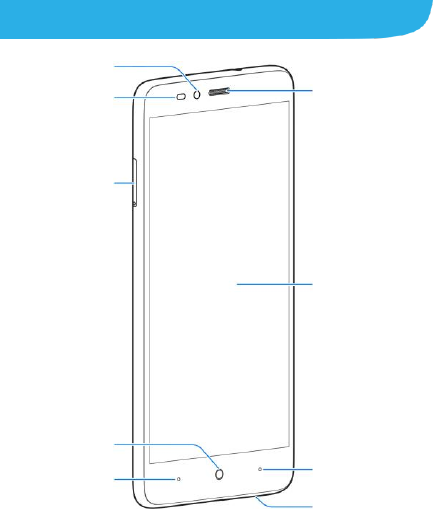
4
Getting to Know Your Phone
Earpiece
Proximity & light
sensor
Back key
Home key with
indicator light
Touch screen
Front camera
Speaker
Recent apps key
nano-SIM/
microSD
card tray
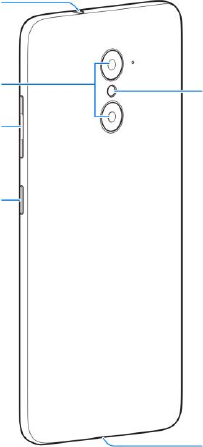
5
Volume key
Charging/
USB Type-C jack
Headset jack
Dual-lens camera
Flash
Power key

6
Power key
Press and hold to turn on or off airplane mode, power off or
restart the phone.
Press to turn off or on the screen display.
Home key
Touch to return to the home screen.
Touch and hold to open Google Search.
Back key
Touch to go to the previous screen.
Recent apps key
Touch to see recently used applications.
Volume key
Press or hold either end of the key to turn the volume up or
down.
NOTE:
The positions of the Back key and the Recent apps key are
interchangeable through Settings > Navigation key.
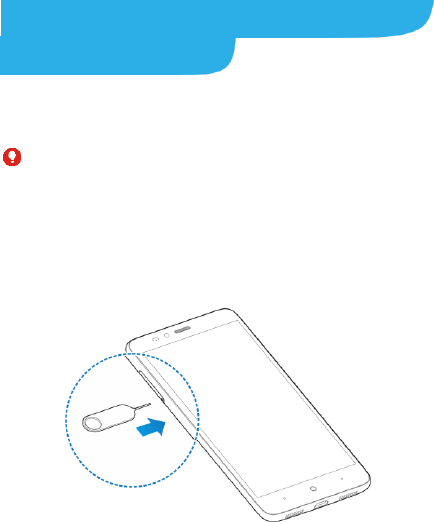
7
Installing the nano-SIM Card and
the microSD Card
The nano-SIM card and the microSD™ card can be installed or
removed while the phone is turned on. You need to unmount the
microSD card (not included) before removing it.
WARNING!
To avoid damage to the phone, do not use any other kind of SIM
cards, or any non-standard nano-SIM card cut from a SIM card.
You can get a standard nano-SIM card from your service
provider.
1. Insert the tip of the tray eject tool into the hole on the card
tray.
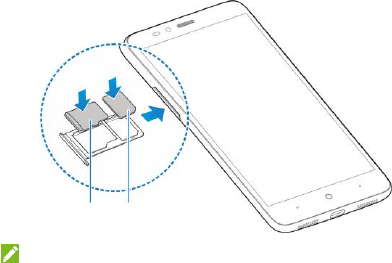
8
2. Pull out the card tray and place the nano-SIM card and the
microSD card on the tray, as shown. Carefully slide the tray
back into place.
NOTE:
Some applications may require a microSD card to work normally
or may store certain data on it. Therefore, it is recommended that
you keep a microSD card installed and not remove or replace it
randomly.
microSD card
nano-SIM card

9
Charging the Battery
Your phone’s battery should have enough power for the phone to
turn on, find a signal, and make a few calls. You should fully charge
the battery as soon as possible.
WARNING!
Use only ZTE-approved chargers and cables. The use of
unapproved accessories could damage your phone or cause
the battery to explode.
CAUTION:
Do not change the built-in rechargeable battery in your
phone by yourself. The battery can only be changed by
ZTE or ZTE authorized service provider.
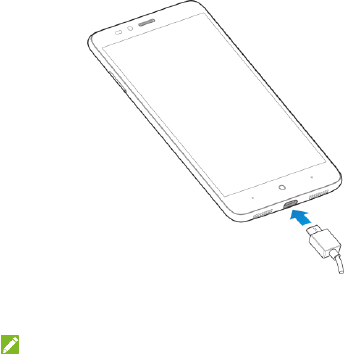
10
1. Connect the adapter to the charging jack.
2. Connect the charger to a standard AC power outlet.
3. Disconnect the charger when the battery is fully charged.
NOTE:
If the battery is extremely low, you may be unable to power on
the phone even when it is being charged. In this case, try again
after charging the phone for at least 20 minutes. Contact the
customer service if you still cannot power on the phone after
prolonged charging.

11
Powering On/Off Your Phone
Press and hold the Power key to turn on your phone.
To turn it off, press and hold the Power key to open the
options menu and then touch Power off > OK.
NOTE:
If the phone freezes or takes too long to respond, you can press
and hold the Power key for about 10 seconds to restart the
phone.
Opening Applications
1. Touch the Home key if the current screen is not the home
screen.
2. Touch .
3. Slide left or right on the screen and touch an app to open
it.
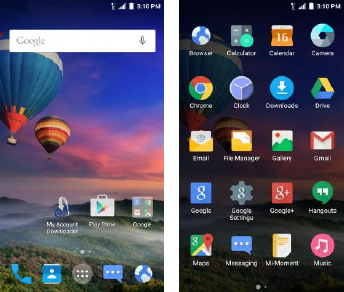
12

13
Customizing Home Screens
You can customize your home screens by adding application
shortcuts, folders, widgets, and more.
Adding Shortcuts and Widgets
1. Touch the Home key > .
- or -
To add widgets, touch and hold an empty area of the home
screen and select Widgets.
2. Slide left or right to browse the available applications or
widgets.
3. Touch and hold a widget or an application icon and drag it to
the home screen. If necessary, drag the shortcut to the left or
right to select other home screen panels.
NOTE:
While holding the item, you can drag it to the right edge of the
screen to create a new home screen panel and put the item on it.
Removing Shortcuts or Widgets
1. Touch and hold a widget or shortcut on the home screen.
2. Drag it to (Delete) to remove it.

14
Organizing Icons With a Folder
1. Touch and hold a shortcut on the home screen and drag it
quickly over another shortcut.
2. Release the shortcut. A new folder will be created and both
shortcuts are added into the folder.
3. If needed, drag more shortcuts and drop them into the folder.
NOTES:
Touch the folder and then touch the name field to rename
the folder.
Drag the folder to (Extract) to delete the folder and
replace its shortcuts on the home screen.
Applying New Wallpapers
1. Touch and hold an empty place on the home screen, and
then touch Wallpapers. You can choose a wallpaper for the
home screen or lock screen.
2. Slide left or right on the wallpaper panel to select a wallpaper,
or touch GALLERY or LIVE WALLPAPER to choose the
image or animation you want to use as the wallpaper. Some
cropping may be needed for Gallery and Photos images.

15
Setting the Theme
1. Touch and hold an empty place on the home screen and
touch Themes.
2. Select a theme you like.
Setting the Home Screen Transition
Effect
1. Touch and hold an empty place on the home screen and
touch Effects.
2. Pick an effect and the phone will demonstrate how it works.
Touch other effects until you find the favourite one.
Managing the Extended Home
Screens
Your home screen is extendable, providing more space for
folders, widgets, and more. Simply swipe left or right on the home
screen to see the extended panels.
To add a new home screen panel:
1. Touch the Home key > , or touch and hold an empty area
of the home screen and select Widgets.
2. Touch and hold an application icon or a widget and drag it to
the right edge of the screen to create a new home screen

16
panel and put the icon or widget on it.
To delete a home screen panel:
1. Touch and hold an empty area of the home screen and slide
left or right to view the home screen thumbnails.
2. Touch on the top right corner of a thumbnail.
3. Touch OK. The items on the panel will also be removed.
NOTE:
No empty home screen panel is allowed to exist. If the icon,
widget or folder is the only item on the current home screen panel,
the panel will be deleted as you remove the item.
To adjust the order of a home screen panel:
1. Touch and hold an empty area of the home screen and slide
left or right to view the home screen thumbnails.
2. Touch and hold a thumbnail and drag it left or right to the
place you need.
NOTE:
Touch at the bottom of a home screen thumbnail to set it as
the main home screen.
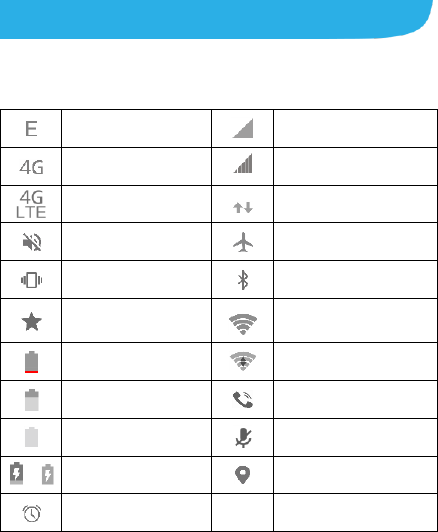
17
Checking the Phone Status
The status bar at the top of the screen displays phone and
service status with various icons on the right side. Below are
some of the icons and their meanings.
2G connected
No signal
3G connected
Signal strength
LTE connected
Mobile data in use
Ringer off
Airplane mode
Vibration mode
Bluetooth on
Priority mode
Connected to a Wi-Fi®
network
Battery low
Wi-Fi in use
Battery partially drained
Speaker on
Battery full
Phone microphone off
/
Battery charging
GPS on
Alarm set
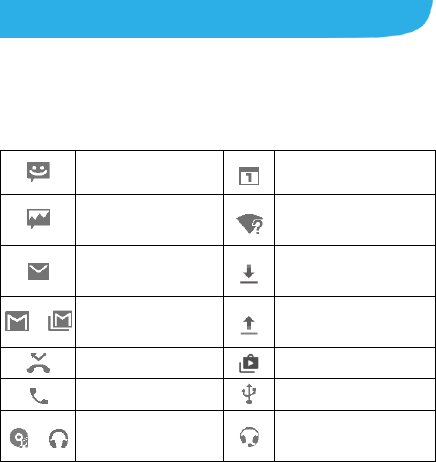
18
Managing Notifications
The status bar at the top of the screen provides notification alerts
with different icons on the left side. Below are some of the icons
and their meanings.
The notifications depend on the apps installed and you can touch
and drag the status bar down to see more information.
New SMS
Upcoming event
New MMS
New Wi-Fi network
detected
New message(s) from
the Email app
Downloading data
/
New message(s) from
the Gmail™ app
Sending data
Missed call
Updates available
Call in progress
USB connected
/
Song playing
Wired headset
connected

19
Calling and Voicemail
Making a Call
1. Touch the Home key > .
2. Touch and enter the phone number or the contact
name with the dialpad. The phone will display matching
information from your contact list.
3. Touch the matching contact to call the contact or touch
to call the number.
NOTE:
You can also touch the search box at the top of the Phone app
screen and enter the phone number or contact name you want
to call. Touch the matching contact or Call [number] to place
the call.
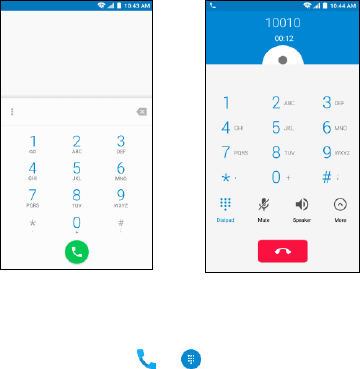
20
Checking Voicemail
1. Touch the Home key > > .
2. Touch and hold the 1 key on the dialpad. If prompted, enter
your voicemail password.
3. Follow the voice prompts to listen to and manage your
voicemail messages.
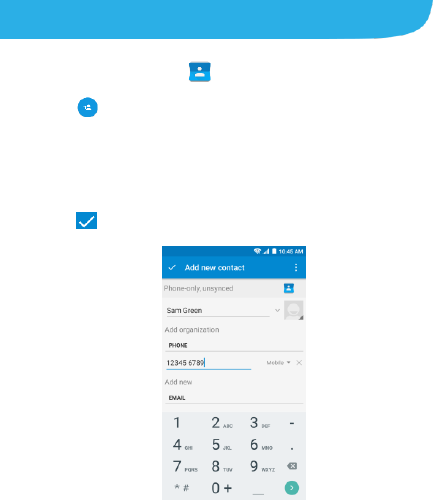
21
Creating a New Contact
1. Touch the Home key > and touch the CONTACTS tab.
2. Touch to add a new contact.
3. If you have multiple account types associated with your
phone, touch the field above Name and select a contact type.
4. Enter the contact name, phone numbers, email addresses,
and other information.
5. Touch to save the contact.
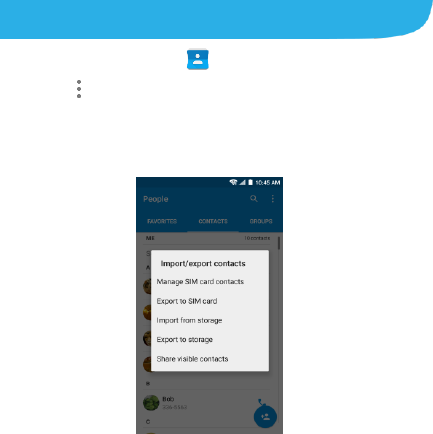
22
Importing Contacts in Batches
1. Touch the Home key > .
2. Touch > Import/Export > Import from storage.
3. Select an account in which to save the contacts.
4. If prompted, choose to import one, multiple, or all vCard files.
5. If prompted, touch OK.

23
Sending a Message
1. Touch the Home key > > .
2. Add recipients by one of the following ways.
Touch the To field and manually enter the recipient’s
number or the contact name. If the phone presents a
few suggestions, touch the one you want to add.
Select recipients from your contacts by touching .
3. Touch the Type message field and enter the content of
your text message.
4. If you want to send a multimedia message, touch the paper
clip icon to attach a file or a slideshow to the message.
5. Touch or SEND.
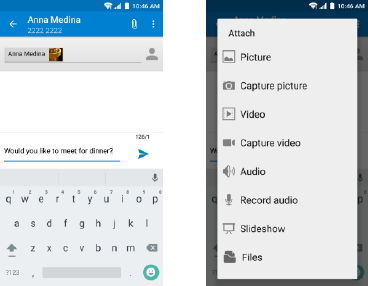
24
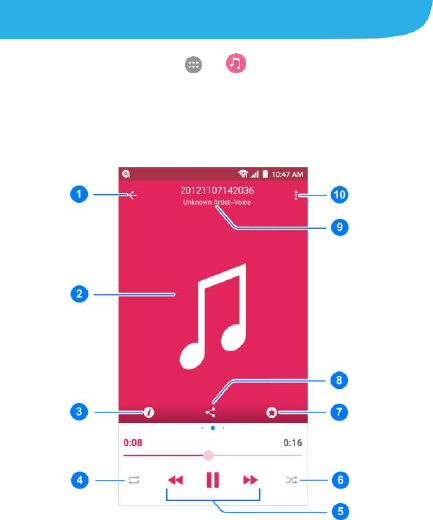
25
Playing Music
1. Touch the Home key > > .
2. Touch All Songs and find the song you want to play.
3. Touch the song to play it. Touch the bar at the bottom to
open the playback screen.

26
Number
Function
1
Return to the music library.
2
Album artwork. Swipe left to see lyrics (if available)
and right the current playlist.
3
Check the track information.
4
Toggle repeat mode: no repeat, repeat the current
track, or repeat the current playlist.
5
Playback control: Skip songs or pause and resume
playback. Drag the progress bar to jump to any part
of the track.
6
Turn on or off shuffle.
7
Add the track to the Favorites playlist.
8
Share the track.
9
Track name, artist, and album information.
10
Access additional options.
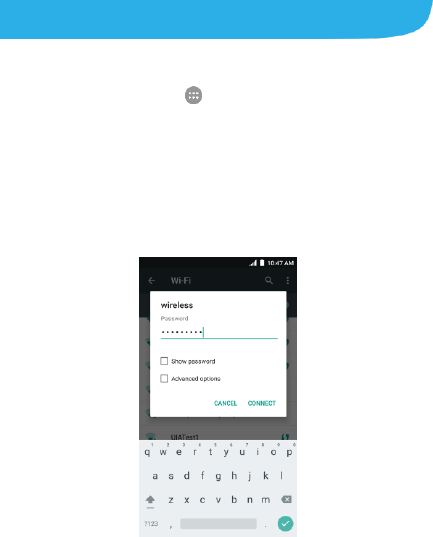
27
Connecting to the Internet
Connecting via Wi-Fi®
1. Touch the Home key > > Settings > Wi-Fi.
2. Touch the Wi-Fi switch if Wi-Fi is off. Your phone
automatically searches for Wi-Fi networks in range and
displays their names and security settings. It also connects
to previously linked networks when they are in range.
3. Touch a network name to connect to it.
If the network is secured, enter a password or other
credentials. (Ask your network administrator for details.)
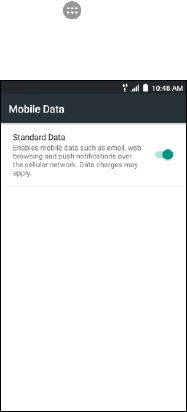
28
Connecting via Mobile Network
1. Touch the Home key > > Settings > Mobile
networks > Mobile Data.
2. Touch the Standard Data switch if it is turned off.

29
Setting Up Email Accounts
Using Gmail
You can use the Gmail app to add your Gmail accounts
and other email accounts such as Yahoo, Hotmail and AOL
Mail.
1. Touch the Home key > > Gmail.
NOTE:
If another Gmail account is already set up, touch the Home
key > > Settings > Accounts and select Google,
Personal (IMAP), or Personal (POP3).
2. Read or skip the instructions for the first time use, and then
touch Add an email address.
3. Select Google or Personal (IMAP/POP) and touch OK.
4. For Gmail account, touch Enter your email to sign in to
your existing Google Account, or touch OR CREATE A
NEW ACCOUNT to create one; for other email accounts,
enter the email address and password.
5. Follow the instructions on the screen to set up your Gmail
or email account.
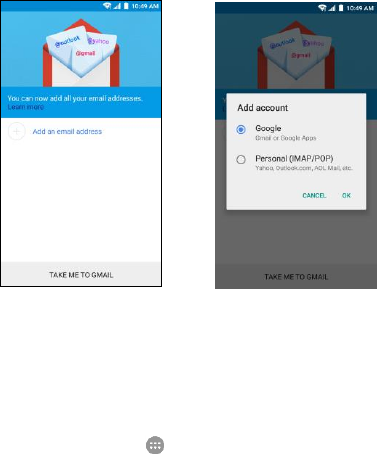
30
Using Email
You can use the Email app to add email accounts including
Microsoft Exchange Active Sync, Gmail, Hotmail, Yahoo,
etc.
1. Touch the Home key > > Email.
2. Select an email server and enter the email address and
password.
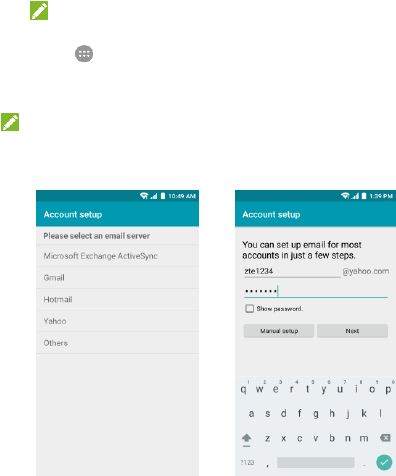
31
NOTE:
If another email account is already set up, touch the Home
key > > Settings > Accounts and select Email or
Corporate.
3. Touch Next and follow the onscreen instructions.
NOTE:
Contact your IT administrator to help set up your corporate
Microsoft Exchange ActiveSync® account.

32
Connecting With a Bluetooth
Headset
1. Turn on the Bluetooth headset and switch it to pairing mode.
Refer to the headset’s user guide for more information.
2. Touch the Home key > > Settings > Bluetooth.
3. Touch the Bluetooth switch if it is off. When Bluetooth is on,
the icon appears in the status bar.
NOTE:
Your phone automatically scans for and displays the IDs of
all available Bluetooth devices in range. Touch >
Refresh if you want to scan again.
4. Touch the ID of the headset, or any other device you want
to pair with your phone. Enter a passcode if prompted.
5. If necessary, touch the ID of the paired headset to connect
with it.
NOTE:
Touch the ID again and then touch OK to end the connection.
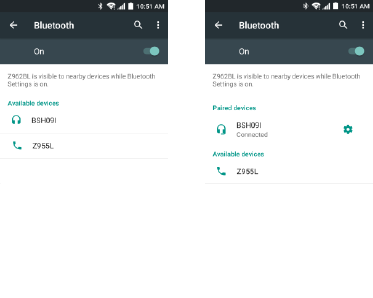
33

34
Installing Apps From the Google
Play™ Store
Google Play has tens of thousands of games and applications
for you to use and enjoy. Before you begin, make sure that you
have signed in to your Google account.
NOTE:
The content you can access in the Play Store depends on your
region and your service provider.
1. Touch the Home key > .
The first time you launch Play Store, accept the Google
Play Terms of Service.
2. Find the apps you need either by category or by touching
.
3. Touch the app to see detailed description.
4. Touch INSTALL (free apps) or the price (paid apps). If the
app is not free, you need to sign in to your Google Wallet™
account and select a payment method.
5. Read the app permissions and touch ACCEPT.
CAUTION:
Once installed, some apps can access many functions or a
significant amount of your personal data. The Play Store
will show you what the app can access.
35
6. For paid apps, touch CONTINUE and follow additional
on-screen instructions for payment.
7. Wait for the app to be downloaded and installed
automatically. Payment needs to be authorized before paid
apps start downloading.
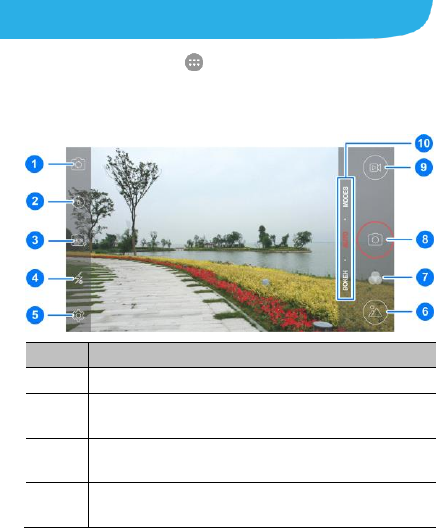
36
Taking a Photo
1. Touch the Home key > > Camera.
2. Aim the camera at the subject and make any necessary
adjustment. Auto camera mode is used by default.
Number
Function
1
Switch between the front and back cameras.
2
Set a time delay before the camera takes a picture
automatically after you touch the shutter icon.
3
Turn on or off the HDR feature, only available for
the back camera.
4
Change the flash setting, only available for the back
camera.
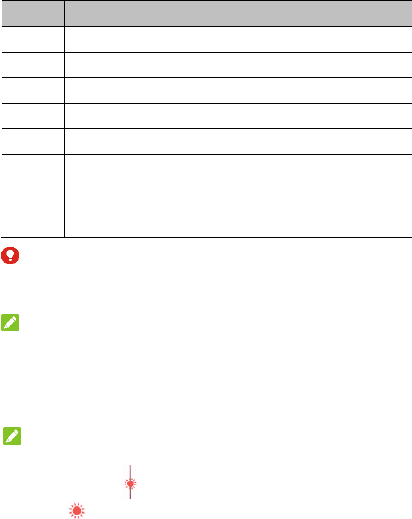
37
Number
Function
5
Change the camera settings.
6
View pictures and videos you have taken.
7
Select a color effect or other special effects.
8
Capture a picture.
9
Capture a video clip.
10
Select a camera or camcorder mode for the back
camera. In addition to the default AUTO mode, you
can touch BOKEH to adjust aperture or touch
MODES to switch to other modes.
WARNING!
Keep a safe distance when using the flash. Do not point the
flash towards the eyes of people or animals.
NOTE:
You can spread or pinch on the screen to zoom in or out
before taking pictures.
3. Touch the area where you want the camera to focus, or
leave the camera to autofocus on the center of the image.
NOTE:
In Auto camera mode, when you touch the screen to focus,
the exposure bar appears beside the focus point. You
can drag up or down to adjust the exposure.

38
4. Lightly touch .
NOTE:
When you use the front camera, you can also touch or
to adjust beauty face or smile detection setting.
Recording a Video
1. Touch the Home key > > Camera.
2. Aim the camera at the subject. You can touch any area on
the screen that you want the camcorder to focus on before
and during recording.
NOTE:
You can spread or pinch on the screen to zoom in or out
before and during recording.
3. Touch to start recording.
NOTE:
While the recording is in progress, touch to pause the
recording. You can also touch to save the frame as a
separate photo.
4. Touch to stop recording.
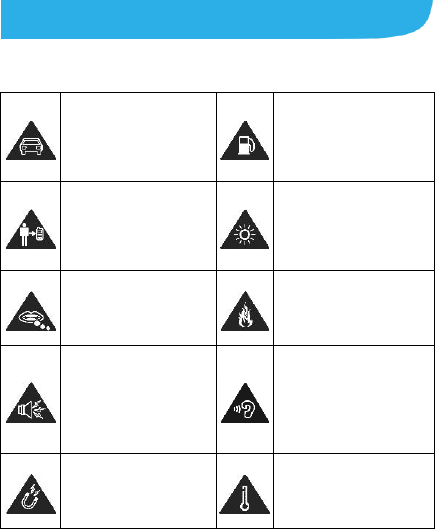
39
For Your Safety
General Safety
Don’t make or receive
handheld calls while
driving. Never text
while driving.
Don’t use at gas
stations.
Keep your phone at
least 15 mm away
from your ear or body
while making calls.
Your phone may
produce a bright or
flashing light.
Small parts may cause
choking.
Don’t dispose of your
phone in fire.
Your phone can
produce a loud sound.
To prevent possible
hearing damage, do
not listen at high
volume levels for long
periods.
Avoid contact with
anything magnetic.
Avoid extreme
temperatures.
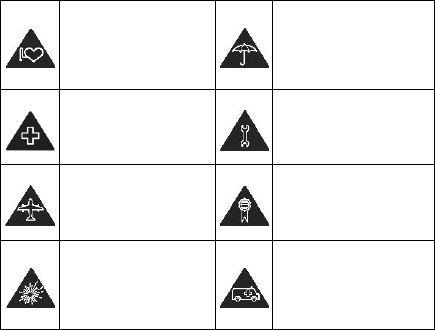
40
Keep away from
pacemakers and other
electronic medical
devices.
Avoid contact with
liquids. Keep your
phone dry.
Turn off when asked to
in hospitals and
medical facilities.
Do not attempt to
disassemble your
phone.
Turn off when told to in
aircrafts and airports.
Only use approved
accessories.
Turn off when near
explosive materials or
liquids.
Don’t rely on your
phone as a primary
device for emergency
communications.
Radio Frequency (RF) Energy
This phone is designed and manufactured not to exceed the
emission limits for exposure to radio frequency (RF) energy set
by the Federal Communications Commission of the United
States.
During SAR testing, this device was set to transmit at its
highest certified power level in all tested frequency bands, and
placed in positions that simulate RF exposure in usage against
41
the head with no separation, and near the body with the
separation of 10 mm. Although the SAR is determined at the
highest certified power level, the actual SAR level of the device
while operating can be well below the maximum value. This is
because the phone is designed to operate at multiple power
levels so as to use only the power required to reach the
network. In general, the closer you are to a wireless base
station antenna, the lower the power output.
The exposure standard for wireless devices employing a unit of
measurement is known as the Specific Absorption Rate, or
SAR. The SAR limit set by the FCC is 1.6 W/kg.
Tests for SAR are conducted using standard operating
positions accepted by the FCC with the device transmitting at
its highest certified power level in all tested frequency bands.
The FCC has granted an Equipment Authorization for this
model phone with all reported SAR levels evaluated as in
compliance with the FCC RF exposure guidelines. SAR
information on this model phone is on file with the FCC and can
be found under the Display Grant section of
www.fcc.gov/oet/ea/fccid after searching on
FCC ID: SRQ-Z962BL.
For this device, the highest reported SAR value for usage
against the head is 0.46 W/kg, for usage near the body is 1.19
W/kg, and for simultaneous transmission is 1.45 W/kg.
While there may be differences between the SAR levels of
various phones and at various positions, they all meet the

42
government requirements.
SAR compliance for body-worn operation is based on a
separation distance of 10 mm between the unit and the human
body. Carry this device at least 10 mm away from your body to
ensure RF exposure level compliant or lower to the reported
level. To support body-worn operation, choose the belt clips or
holsters, which do not contain metallic components, to maintain
a separation of 10 mm between this device and your body.
RF exposure compliance with any body-worn accessory, which
contains metal, was not tested and certified, and using such
body-worn accessory should be avoided.
FCC Regulations
This device complies with part 15 of the FCC Rules. Operation
is subject to the following two conditions: (1) This device may
not cause harmful interference, and (2) this device must accept
any interference received, including interference that may
cause undesired operation.
CAUTION:
Changes or modifications not expressly approved by the
manufacturer could void the user’s authority to operate the
equipment.
The antenna(s) used for this transmitter must not be co-located
or operating in conjunction with any other antenna or
transmitter.

43
NOTE:
This equipment has been tested and found to comply with the
limits for a Class B digital device, pursuant to part 15 of the
FCC Rules.
These limits are designed to provide reasonable protection
against harmful interference in a residential installation. This
equipment generates, uses and can radiate radio frequency
energy and, if not installed and used in accordance with the
instructions, may cause harmful interference to radio
communications. However, there is no guarantee that
interference will not occur in a particular installation. If this
equipment does cause harmful interference to radio or
television reception, which can be determined by turning the
equipment off and on, the user is encouraged to try to correct
the interference by one or more of the following measures:
Reorient or relocate the receiving antenna.
Increase the separation between the equipment and receiver.
Connect the equipment into an outlet on a circuit different
from that to which the receiver is connected.
Consult the dealer or an experienced radio/TV technician for
help.
44
Hearing Aid Compatibility (HAC)
regulations for Mobile phones
In 2003, the FCC adopted rules to make digital wireless
telephones compatible with hearing aids and cochlear implants.
Although analog wireless phones do not usually cause
interference with hearing aids or cochlear implants, digital
wireless phones sometimes do because of electromagnetic
energy emitted by the phone's antenna, backlight, or other
components. Your phone is compliant with FCC HAC
regulations (ANSI C63.19- 2011). While some wireless phones
are used near some hearing devices (hearing aids and
cochlear implants), users may detect a buzzing, humming, or
whining noise. Some hearing devices are more immune than
others to this interference noise and phones also vary in the
amount of interference they generate. The wireless telephone
industry has developed a rating system for wireless phones to
assist hearing device users in finding phones that may be
compatible with their hearing devices. Not all phones have
been rated. Phones that are rated have the rating on their box
or a label located on the box. The ratings are not guarantees.
Results will vary depending on the user's hearing device and
hearing loss. If your hearing device happens to be vulnerable
to interference, you may not be able to use a rated phone
successfully. Trying out the phone with your hearing device is
the best way to evaluate it for your personal needs.
45
This phone has been tested and rated for use with hearing aids
for some of the wireless technologies that it uses. However,
there may be some newer wireless technologies used in this
phone that have not been tested yet for use with hearing aids.
It is important to try the different features of this phone
thoroughly and in different locations, using your hearing aid or
cochlear implant, to determine if you hear any interfering noise.
Consult your service provider or the manufacturer of this phone
for information on hearing aid compatibility. If you have
questions about return or exchange policies, consult your
service provider or phone retailer.
M-Ratings: Phones rated M3 or M4 meet FCC requirements
and are likely to generate less interference to hearing devices
than phones that are not labeled. M4 is the better/higher of the
two ratings.
T-Ratings: Phones rated T3 or T4 meet FCC requirements and
are likely to be more usable with a hearing device’s telecoil (“T
Switch” or “Telephone Switch”) than unrated phones. T4 is the
better/ higher of the two ratings. (Note that not all hearing
devices have telecoils in them.)
Your phone meets the M4 /T3 level rating.
Hearing devices may also be rated. Your hearing device
manufacturer or hearing health professional may help you find
this rating. For more information about FCC Hearing Aid
Compatibility, please go to http://www.fcc.gov/cgb/dro.
46
CTIA Requirements
Do not disassemble or open, crush, bend or deform, puncture
or shred the battery.
Do not modify or remanufacture, attempt to insert foreign
objects into the battery, immerse or expose to water or other
liquids, expose to fire, explosion or other hazard.
Only use the battery for the system for which it is specified.
Only use the battery with a charging system that has been
qualified with the system per CTIA Certification Requirements
for Battery System Compliance to IEEE 1725. Use of an
unqualified battery or charger may present a risk of fire,
explosion, leakage, or other hazard.
Do not short circuit a battery or allow metallic conductive
objects to contact the battery terminals.
Only authorized service providers shall replace battery.
Promptly dispose of used batteries in accordance with local
regulations.
Battery usage by children should be supervised.
Avoid dropping the phone or battery. If the phone or battery is
dropped, especially on a hard surface, and the user suspects
damage, take it to a service center for inspection.
Improper battery use may result in a fire, explosion or other
hazard.
47
The phone shall only be connected to CTIA certified adapters,
products that bear the USB-IF logo or products that have
completed the USB-IF compliance program.
Distraction
Driving
Full attention must be given to driving at all times in order to
reduce the risk of an accident. Using a phone while driving (even
with a hands free kit) can cause distraction and lead to an
accident. You must comply with local laws and regulations
restricting the use of wireless devices while driving.
Operating Machinery
Full attention must be given to operating the machinery in
order to reduce the risk of an accident.
Product Handling
General Statement on Handling and Use
You alone are responsible for how you use your phone and any
consequences of the use.
You must always switch off your phone wherever the use of a
phone is prohibited. Use of your phone is subject to safety
measures designed to protect users and their environment.
48
Always treat your phone and its accessories with care and
keep them in a clean place.
Keep the screen and camera lens clean. Unclean screen or
camera lens may slow down the phone's reaction to your
operations or lower image quality.
Clean your phone and its accessories with a soft material
such as cleaning cloth for eyeglass lenses. Do not use
alcohol or other corrosive substances for cleaning or allow
them to get inside.
Do not expose your phone or its accessories to open flames
or lit tobacco products.
Do not expose your phone or its accessories to liquid,
moisture or high humidity.
Do not drop, throw or try to bend your phone or its
accessories.
Do not use harsh chemicals, cleaning solvents, or aerosols to
clean the device or its accessories.
Do not paint your phone or its accessories.
Do not attempt to disassemble your phone or its accessories,
only authorized personnel can do so.
Do not expose or use your phone or its accessories in an
environment with or that can reach extreme temperatures,
minimum 23 ℉ and maximum 122 ℉ (minimum - 5 ℃ and
49
maximum + 50 ℃).
Do not place your phone inside or near heating equipments or
high pressure containers, such as water heaters, microwave
ovens, or hot cooking utensils. Otherwise, your phone may be
damaged.
Please check local regulations for disposal of electronic
products.
Do not carry your phone in your back pocket as it could break
when you sit down.
Only authorized service providers shall replace battery.
Small Children
Do not leave your phone and its accessories within the reach of
small children or allow them to play with it.
They could hurt themselves or others, or could accidentally
damage the phone.
Your phone contains small parts with sharp edges that may
cause an injury or may become detached and create a choking
hazard.
Demagnetization
To avoid the risk of demagnetization, do not allow electronic
devices or magnetic media close to your phone for a long time.
50
Electrostatic Discharge (ESD)
Do not touch the metallic connectors of the nano-SIM card.
Antenna
Do not touch the antenna unnecessarily.
Normal Use Position
When placing or receiving a phone call, hold your phone to your
ear, with the bottom toward your mouth.
Air Bags
Do not place your phone in the area over an air bag or in the air
bag deployment area as an airbag inflates with great force and
serious injury could occur.
Place your phone safely before driving your vehicle.
Seizures/Blackouts
Your phone can produce a bright or flashing light. A small
percentage of people may be susceptible to blackouts or
seizures (even if they have never had one before) when exposed
to flashing lights or light patterns such as when playing games or
watching videos. If you have experienced seizures or blackouts
or have a family history of such occurrences, please consult a
physician. To reduce the risk of blackouts or seizures, you can
use your phone in a well-lit room and take frequent breaks.
51
Repetitive Strain Injuries
To minimize the risk of Repetitive Strain Injury (RSI) when texting
or playing games with your phone:
Do not grip the phone too tightly.
Press the buttons lightly.
Use the special features which are designed to minimize the
times of pressing buttons, such as Message Templates and
Predictive Text.
Take frequent breaks to stretch and relax.
Emergency Calls
This phone, like any other wireless phone, operates using radio
signals, which cannot guarantee connection in all conditions.
Therefore, you should not rely solely on any wireless phone for
emergency communications.
Loud Noise
This phone is capable of producing loud noises, which may
damage your hearing. Turn down the volume before using
headphones, Bluetooth headsets or other audio devices.
Phone Heating
Your phone may become warm during charging and normal use.
52
Electrical Safety
Accessories
Use only approved accessories.
Do not connect with incompatible products or accessories.
Take care not to touch metallic objects, such as coins or key
rings, or allow them to contact or short-circuit the charging jack
terminals.
Never puncture the surface of the phone with sharp objects.
Connection to a Car
Seek professional advice when connecting a phone interface to
the vehicle electrical system.
Faulty and Damaged Products
Do not attempt to disassemble the phone or its accessories.
Only qualified personnel can service or repair the phone or its
accessories.
If your phone (or its accessories) has been submerged in water,
punctured, or subjected to a severe fall, do not use it until you
have taken it to be checked at an authorized service center.
53
Radio Frequency Interference
General Statement on Interference
Care must be taken when using your phone in close proximity to
personal medical devices, such as pacemakers and hearing aids.
Please consult your doctor and the device manufacturers to
determine if the operation of your phone may interfere with the
operation of your medical devices.
Pacemakers
Pacemaker manufacturers recommend that a minimum
separation of 15 cm be maintained between a mobile phone and
a pacemaker to avoid potential interference with the pacemaker.
To achieve this, use the phone on the opposite ear to your
pacemaker and do not carry it in a breast pocket.
Hearing Aids
People with hearing aids or other cochlear implants may
experience interfering noises when using wireless devices or
when one is nearby.
The level of interference will depend on the type of hearing
device and the distance from the interference source,
increasing the separation between them may reduce the
interference. You may also consult your hearing aid
manufacturer to discuss alternatives.
54
Medical Equipment
Switch off your wireless device when you are requested to do
so in hospitals, clinics or health care facilities. These requests
are designed to prevent possible interference with sensitive
medical equipment.
Aircraft
Switch off your wireless device whenever you are instructed to
do so by airport or airline staff.
Consult the airline staff about the use of wireless devices on
board the aircraft and enable airplane mode of your phone
when boarding an aircraft.
Interference in Vehicles
Please note that because of possible interference to electronic
equipment, some vehicle manufacturers forbid the use of
mobile phones in their vehicles unless a hands-free kit with an
external antenna is included in the installation.
Explosive Environments
Gas Stations and Explosive Atmospheres
In locations with potentially explosive atmospheres, obey all
posted signs to turn off wireless devices such as your phone or
other radio equipment.
55
Areas with potentially explosive atmospheres include fuelling
areas, below decks on boats, fuel or chemical transfer or
storage facilities, areas where the air contains chemicals or
particles, such as grain, dust, or metal powders.
Blasting Caps and Areas
Power off your mobile phone or wireless device when in a
blasting area or in areas where signs are posted to power off
“two-way radios” or “electronic devices” to avoid interfering with
blasting operations.